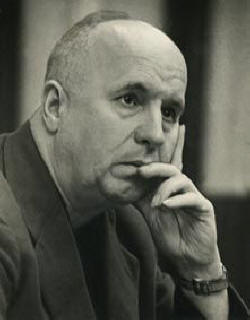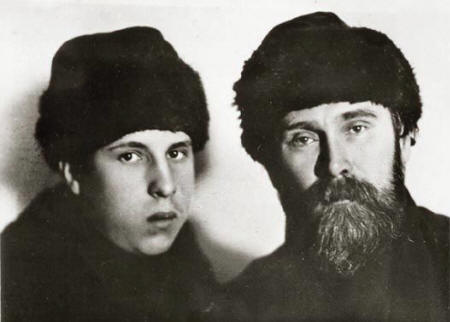

Partner Nikolai Klyuev
Queer Places:
Kuntsevskoye Cemetery
Moscow, Moscow Federal City, Russia
 Anatoly Nikiforovich Yar-Kravchenko, born Anatoly Nikiforovich Kravchenko (June
21, 1911 - November 24, 1983) was a Russian painter, graphic artist and portraitist. [1][2]
Nikolai Klyuev was homosexual and had love affairs in Vytegra in the immediate post-revolutionary years, and before settling in Saint Petersburg in the 1920s. Nevertheless, by the 1920s the evidence of active homosexual relationships become more evident in the account of his life, as well as his poetry. In 1928 he met his great love, Anatoly Kravchenko, a young artist. The two lived as companions in Leningrad until Kravchenko's marriage in 1933, which came as a blow to Klyuev.
Homo-eroticism can be found in Klyuev's poetry from as early as the late 1910s. By the 1930s a more romanticized form of homosexual love is found addressed in the poems to Kravchenko.
Anatoly Nikiforovich Yar-Kravchenko, born Anatoly Nikiforovich Kravchenko (June
21, 1911 - November 24, 1983) was a Russian painter, graphic artist and portraitist. [1][2]
Nikolai Klyuev was homosexual and had love affairs in Vytegra in the immediate post-revolutionary years, and before settling in Saint Petersburg in the 1920s. Nevertheless, by the 1920s the evidence of active homosexual relationships become more evident in the account of his life, as well as his poetry. In 1928 he met his great love, Anatoly Kravchenko, a young artist. The two lived as companions in Leningrad until Kravchenko's marriage in 1933, which came as a blow to Klyuev.
Homo-eroticism can be found in Klyuev's poetry from as early as the late 1910s. By the 1930s a more romanticized form of homosexual love is found addressed in the poems to Kravchenko.

Anatolii Kravchenko
and Nikolai Klyuev
Kravchenko was the son of the traffic engineer Nikofor Pavlovich Kravchenko, who moved frequently with his family and settled in 1921 in the dach village of Sviatoshin on the outskirts of Kiev. At school, the young Kravchenko was particularly eager to follow the drawing lessons of V. J. Ryabchevsky, who was a pupil of Ivan Shishkin. He drew a lot, and his drawings were exhibited. The father went to Moscow with his twelve-year-old son and sought and found an art training place in N. I. Kravchenko's studio. However, since their father could not find a job in Moscow, they had to return to Sviatoshino. In 1925, the young Kravchenko graduated from the seven-year school. In 1927 he went to the preparatory course at the Kiev Art Institute. He also studied with Ivan Fyodorovich Selesnyov, a pupil of Pavel Petrovich Chistyakov. [1] Since Kravchenko rejected the Kiev Art Institute, he went to Leningradin 1928 to complete his artistic training. He was close to the writer Nikolai Alekseyevich Klyuyev, who strongly influenced him and advised him to add the prefix Yar (gorge) to his name. [3][4] In 1935, Yar Kravchenko went to Sochi to meet Nikolai Alekseyevich Ostrovsky to paint a portrait of him. This is the only lifelike Ostrowski portrait. [1] Yar Kravchenko graduated from the Leningrad Institute of Painting, Sculpture and Architecture with Isaak Israilevich Brodsky in 1939. He painted only a little. His most famous painting is Maxim Gorky, who re recites his story The Girl and Death on October 11, 1931 Stalin, Molotov and Voroshilov (1940). After the start of the German-Soviet War, Yar-Kravchenko joined the Red Army as a volunteer in July 1941 and served in the Air Force. He camouflaged airfields, defended Leningrad during the Leningrad Blockade, flew as a gunner-radio operator in dive bombers and drew in the army newspaper Ataka, so that in almost every issue his drawings with war heroes and everyday urban life appeared. Frontal albums with his drawings were given to excellent pilots and flying units. [5] His portraits of the heroes of the Soviet Union appeared on postcards. [1] Yar Kravchenko created the portraits of over 300 Soviet writers. In 1947, his separate graphic album with a gallery of Soviet writers was released. He also drew portraits of foreign writers, such as theodore Dreiser, O. Henry and Rabindranath Tagore. He created graphic portraits of Stalin, including Stalin in the coffin. His portraits of Khrushchev and Gagarin adorned the grandstand of the Lenin Mausoleum in celebration of Gagarin's return from his space flight in 1961.[6] Many of his portraits appeared on stamps and envelopes of the USSR post office. From 1972 to 1977, Yar-Kravchenko headed the All-Union Society of Philatelists as successor to Ernst Theodorovich Krenkel. [1]
My published books: